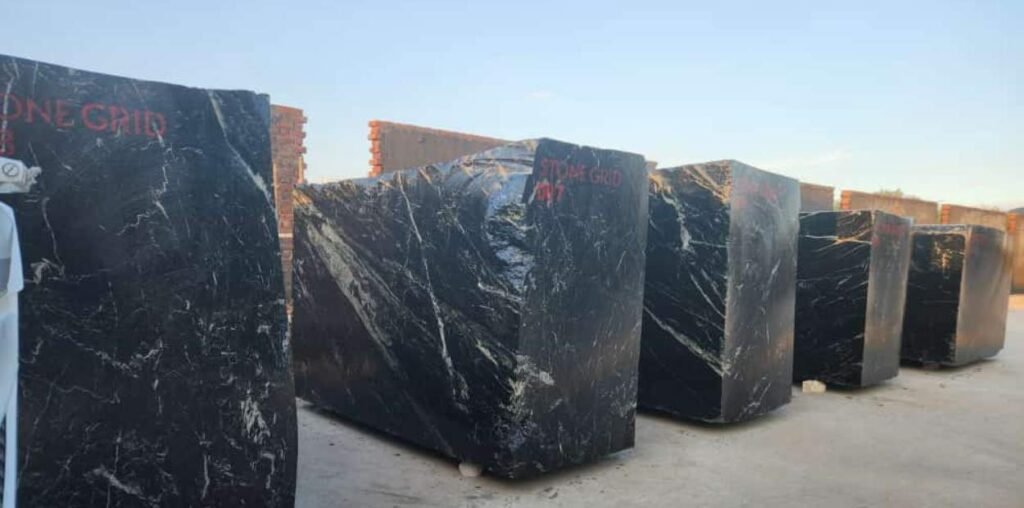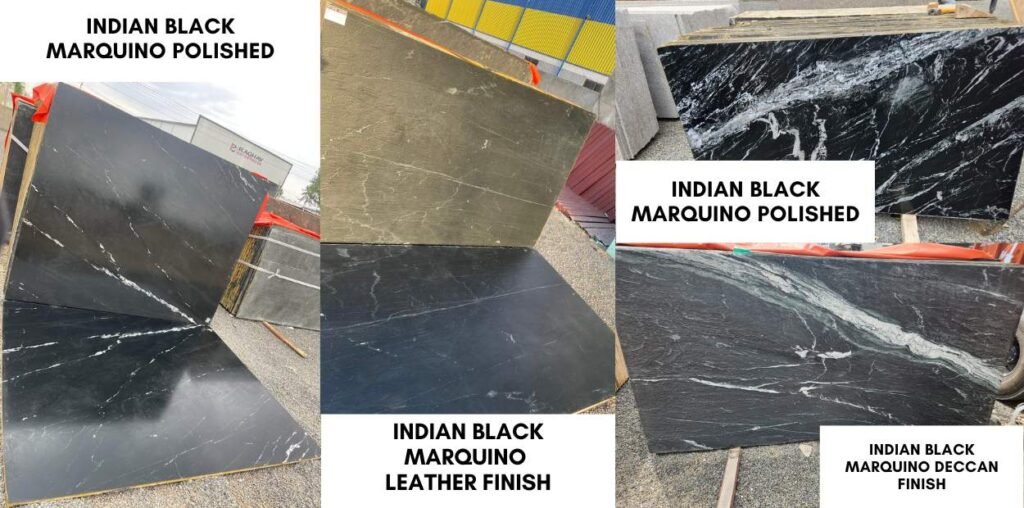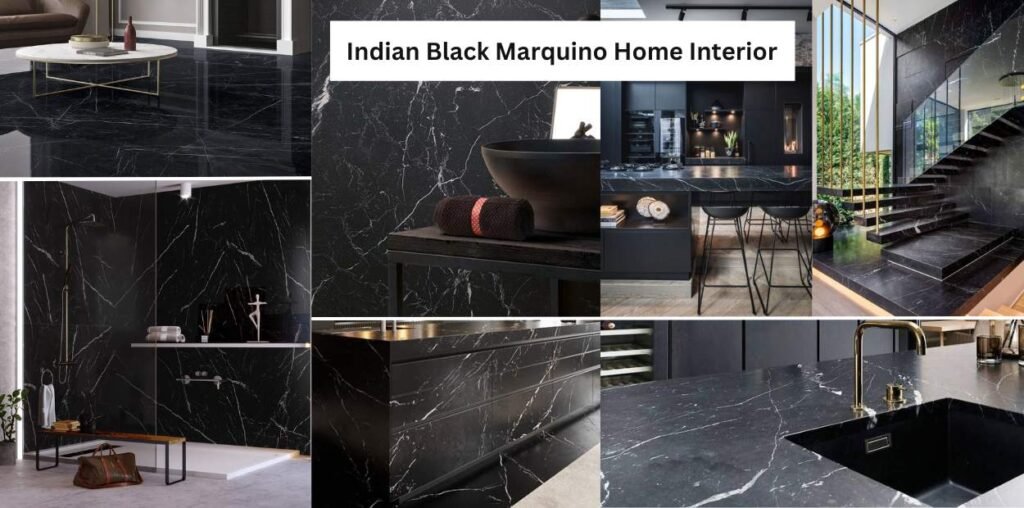
Udaipur Black Marble is formed naturally through a geological process that takes millions of years. It is a type of metamorphic rock, just like other marbles, and is primarily composed of calcite or dolomite minerals. Here’s a brief overview of how black marble is formed naturally in India, focusing on Udaipur Black Marble:
- Geological Formation: Indian Black Marble, like many other black marbles, starts its journey as limestone or dolostone. These sedimentary rocks accumulate over millions of years on the ocean floor through the deposition of calcium carbonate-rich organic materials, shells, and sediments.
- Heat and Pressure: Over time, geological processes such as tectonic plate movements cause these sedimentary rocks to be buried deeper within the Earth’s crust. As they are buried, the rocks experience intense heat and pressure. This process, known as metamorphism, transforms the sedimentary rocks into crystalline structures, changing their mineral composition.
- Mineral Recrystallization: During metamorphism, the calcite or dolomite minerals within the limestone or dolostone recrystallize into larger, interlocking crystals. This recrystallization process gives marble its characteristic smooth and often shiny appearance.
- Impurities and Coloration: The presence of various impurities and minerals in the original rock can influence the coloration of the marble. In the case of Udaipur Black Marble, the deep black color is often attributed to the presence of graphite and other organic matter. Veining and other patterns can develop based on the mineral composition and geological conditions.
- Extraction and Quarrying: Once the metamorphosed rock is exposed to the Earth’s surface, it can be quarried for marble extraction. In the case of Indian Black Marble, the quarries in and around Udaipur, Rajasthan, India, are famous for producing this exquisite black marble. These quarries are meticulously managed to extract large blocks of marble.
- Processing: The extracted marble blocks are then transported to processing units, where they are cut into slabs, polished, and finished to meet the desired specifications. This processing enhances the natural beauty of the marble and brings out its unique patterns and veining.
- Utilization in Construction and Design: Udaipur Black Marble, like other black marbles, is highly sought after for its aesthetic appeal and suitability for various applications. It is commonly used in interior and exterior architectural projects, including flooring, wall cladding, countertops, and decorative elements. Its deep black color and distinct veining make it a favorite choice for creating elegant and luxurious spaces.
Types of finishing Popular in Indian black marble?

Indian Black Marble is a versatile material that can be used in various finishes to achieve different aesthetic and functional effects in interior design and architecture. Here are some common marble finishes available at Stone Grid Kishangarh Showroom and how and where you can use them with Indian Black Marble:
Polished Finish:
- How: Achieved by grinding and buffing the marble surface until it is highly reflective and smooth.
- Where to Use: Polished Indian Black Marble is perfect for high-end, luxurious spaces. It enhances the natural beauty of the stone, making it ideal for flooring, countertops, and wall cladding in areas where you want a glossy, sophisticated appearance.
Brushed Finish:
- How: Achieved by brushing the marble surface with abrasive brushes to create a textured, antique-like finish.
- Where to Use: Brushed Indian Black Marble adds a rustic, aged look to spaces. It’s often used in outdoor applications, such as patios and walkways, but can also be used indoors for a unique and textured appearance.
Deccan Finish:
- How: The surface is subjected to high heat, causing it to erupt into a rough, textured finish with a slightly faded color.
- Where to Use: Flamed Indian Black Marble is typically used for outdoor applications like pool surrounds, driveways, and exterior walls due to its slip-resistant properties. It’s not typically used indoors because of its rough texture.
Leathered Finish:
- How: Created by brushing the marble’s surface with abrasive brushes, but with less pressure than a brushed finish, resulting in a slightly textured appearance with a soft sheen.
- Where to Use: Leathered Indian Black Marble combines a rustic texture with a touch of elegance. It’s an excellent choice for kitchen countertops, bathroom vanities, and fireplace surrounds, offering a unique tactile experience.
Tumbled Finish:
- How: Achieved by tumbling the marble pieces in a drum with abrasive materials to create a weathered, antique appearance.
- Where to Use: Tumbled Indian Black Marble is often used for accent pieces, backsplashes, and decorative elements in both indoor and outdoor settings. It imparts a timeless, aged look to surfaces.
Antique Finish:
- How: This finish involves distressing the marble to create a heavily weathered and aged appearance.
- Where to Use: Antique Indian Black Marble is used for special design features, statement walls, and artistic installations. It’s an unconventional choice that adds character and drama to interiors.
Indian Black Marble brings a touch of natural elegance and luxury to home interiors like no other material. Its rich black background provides a stunning backdrop for various design elements. Here’s how it elevates interior spaces:
- Timeless Elegance: The deep black color of Indian Black Marble creates a sense of opulence and sophistication that never goes out of style. It seamlessly fits into both contemporary and classic interior designs, adding a touch of timeless elegance.
- Luxurious Contrast: The subtle veins and patterns found in Indian Black Marble add depth and character to spaces. When used in large slabs or as accent pieces, it creates a luxurious contrast that captures the attention of anyone entering the room.
- Versatile Complement: Indian Black Marble works harmoniously with a variety of materials, such as wood, metal, and glass. Its versatility allows it to adapt to various design themes, from minimalistic and industrial to lavish and ornate.

Why it's trending for export purposes?
Udaipur Black Marble, also known as Rajasthan Black Marble, is indeed trending for export purposes for several compelling reasons:
Exquisite Aesthetic Appeal: Udaipur Black Marble is renowned for its deep black color with subtle white or gold veining. This striking contrast creates a visually stunning and elegant appearance, making it highly desirable for luxury interior and exterior applications. The aesthetic appeal of this marble is a key factor driving its popularity in export markets.
Versatility in Design: Its versatility in design applications is another significant reason behind its export popularity. Udaipur Black Marble can be used in a wide range of projects, from modern and minimalistic designs to classic and opulent settings. Its adaptability to various design styles allows it to cater to a broad customer base.
- Natural Rarity: Udaipur Black Marble is relatively rare, especially when compared to more commonly available marble varieties. This scarcity adds to its desirability, making it a premium choice for those seeking unique and exclusive materials for their projects. The limited availability of this marble contributes to its trending status.
Durability and Longevity: Marble is known for its durability and longevity, and Udaipur Black Marble is no exception. When properly maintained, it can withstand the test of time, making it a practical and wise choice for export markets where clients seek materials that will last.
Global Appeal: Udaipur Black Marble’s universal aesthetic appeal transcends cultural boundaries, making it attractive to a global market. It is not limited to a specific region or style, which enhances its export potential.
- Heritage and Craftsmanship: Rajasthan, and Udaipur in particular, has a rich heritage of marble craftsmanship. The skill and expertise of local artisans contribute to the high-quality finished products that are exported. Buyers often appreciate the craftsmanship and artistry behind Udaipur Black Marble products.
- Interior Design Trends: Interior design trends often influence material choices, and Udaipur Black Marble aligns well with the current preference for luxurious and elegant interior spaces. Its timeless beauty resonates with contemporary design aesthetics, making it a sought-after choice for interior designers and architects worldwide.
- Unique Properties: Udaipur Black Marble possesses unique properties, such as its ability to maintain a cool temperature, which makes it a practical choice for hot climates. It is also easy to clean and maintain, adding to its appeal for export markets.
Natural and Sustainable: In an era where sustainability is a concern, natural stone materials like Udaipur Black Marble are favored for their eco-friendliness. They are considered more sustainable than synthetic alternatives, which aligns with the values of environmentally conscious consumers.
Please feel free to inquire about Indian Black Marquino. We have our own mines and factory, allowing us to offer fresh lots of Black Marble at factory rates. Our complete collection is available at our showroom in Kishangarh. To book an appointment, please contact us at +91-9145919700 to visit our showroom. We look forward to assisting you with your marble needs.

Pingback: How Indian, Udaipur Black Marble, is formed nat...
Pingback: https://stonegrid.in/how-indian-udaipur-black-m...
Pingback: Opal White Marble first choice of Interior and Architects - Stone Grid: Natural Stone Marble and Granite Mines Manufacturing